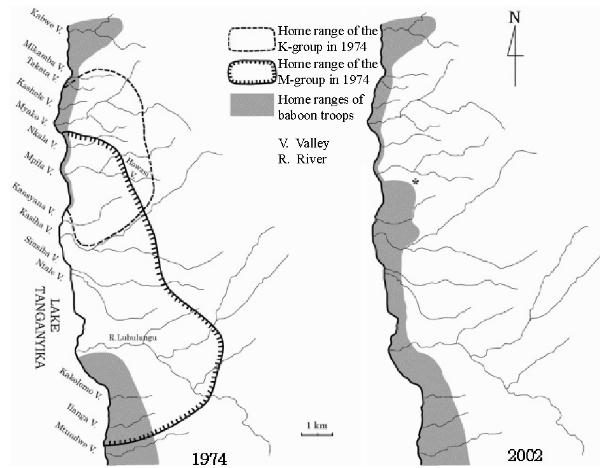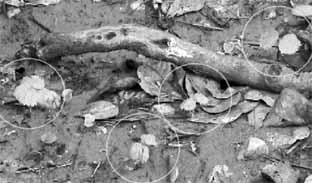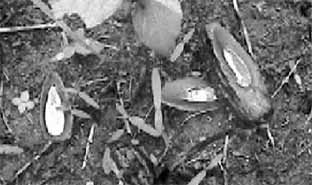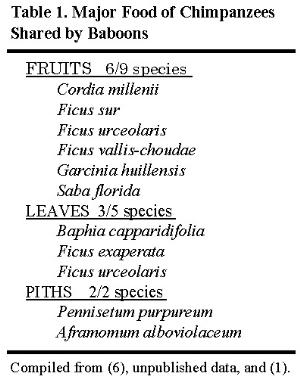|
Competition between Baboons and Chimpanzees at Mahale.
Toshisada Nishida Graduate School of Science, Kyoto University It appears that the yellow baboons of Kasoje have recently increased in number and expanded their ranges enormously at the cost of the M group chimpanzee range (1, 2). The question of why they have expanded their ranges is addressed here. Before the national park was established, there were only two baboon troops at Kasoje, one in the southern region and the other in the northern region. The northern troop’s range, which S. Uehara and I had studied in 1973–74, was very narrow and limited to the open areas along the shoreline of Lake Tanganyika (Fig. 1) (3). Kasiha Village was at the northern limit of the troop range, and since villagers were antagonistic to crop-raiders, baboons did not penetrate more deeply into the Kasoje area at that time. |
 |
|
Figure 1 Expansion of the range use by baboons 1974–2002 (Estimate) * G4-1 point |
|
After the resident people moved out of the park area in 1975, baboons did not face any obstacles to expanding their ranges. Moreover, fruit trees such as oil palms, mango trees and guava trees, formerly protected by the villagers, suddenly fell into their possession. In particular, oil palm fruit, which is highly nutritious, became their favorite food item. Now, five to six, instead of two, baboon troops reside within the M group study area (5). They also began to invade the interior forested areas, which they had never used before (Fig. 1). In the early 1990s, I noticed food remnants such as chewed stalks of elephant grass along the path from Kasiha Village to Kansyana Camp, 1 km inland from the lake. In April, 1992, baboons came to the Kansyana Camp and stole dried fish from the camp kitchen (Uehara, unpublished). In 1995, baboons first fed on the fruits of the Pseudospondias tree, which had been used only by chimpanzees before (2). In October 2002, they reached as far as the G4-1 point (* in Fig.1) and began to eat Garcinia fruits, which were the M group chimpanzees’ major food resource in the late dry–early rainy season.
One possible consequence of the baboon invasion is more frequent use of the higher part of the range by M group chimpanzees. Although the long-term changes in the range use pattern of chimpanzees has not been systematically studied, the drastic decrease in some food plants such as Harungana madagascariensis has already been noticed in 1992 (Uehara, unpublished) (4). Therefore, both baboon invasion and vegetation changes would be responsible for the more extensive use of the higher part by chimpanzees. In 1994, we had to cut a new trail, Route 7, known as the “Skyway”, above Route 6, then the highest trail, in order to follow chimpanzees. From May to July 1994, it was impossible for us to study chimpanzees without this new trail. It is likely that baboons are winning the competition with chimpanzees. First, baboons have a wider food repertoire than do chimpanzees. Baboons eat almost all of the major foods of the M group chimpanzees (Table 1). According to (1), during their two-month study period in 1998–99, baboons ate 36 species of plants, while chimpanzees ate only 18 species. Moreover, baboons can ingest even unripe fruits, while chimpanzees mostly eat only ripe fruits. This dietary difference in effect deprives the chimpanzees of several food sources they previously enjoyed. For example, although chimpanzees used to eat mango fruits in the 1980s, they have not been observed to do so for at least the past five years. Should we assume that this takeover of chimpanzee ranges by baboons is a completely natural process? I do not think so.
First, of course, oil palms and mango trees are not indigenous but were planted by humans. Second, I speculate that the recent invasion of the chimpanzee range by baboons has been facilitated partly by the widening of observation paths for the convenience of tourists. The park tourism strategy appears to have provided an opener and dryer environment that is more conducive to baboon survival. Oil palms are most nutritious food of baboons introduced by humans. Since chimpanzees of M group do not eat them, the destruction of oil palms would have little, if any, influence on the nutritional status of the chimpanzees.
I want to point out that baboons influence the ecosystem in another aspect. Chimpanzees eat the pulp of fruits such as Cordia, swallow the seeds, and eliminate them in defecation; as a result, some of these seeds germinate after being transported by the walking and digesting chimpanzees (Fig. 2). In contrast, baboons not only eat fruit pulp but also ingest kernels inside the hard seeds of Cordia recovered from the feces of chimpanzees (Fig. 3). This can hinder the seed dispersal by chimpanzees and thus deter their contribution to forest-regeneration. For baboons, however, such a transformation would be adaptive to them because it would make the habitat more savanna-like, since Cordia is a forest tree. However, the degree of influence this baboon habit has on the ecosystem cannot be estimated without detailed research. |
 |
 |
| Figure 2 Seedlings of Cordia millenii which germinated from chimpanzee feces. | Figure 3 Seeds of Cordia millenii which were evacuated by chimpanzees and then destroyed by yellow baboons. |
References
Back to Contents |
